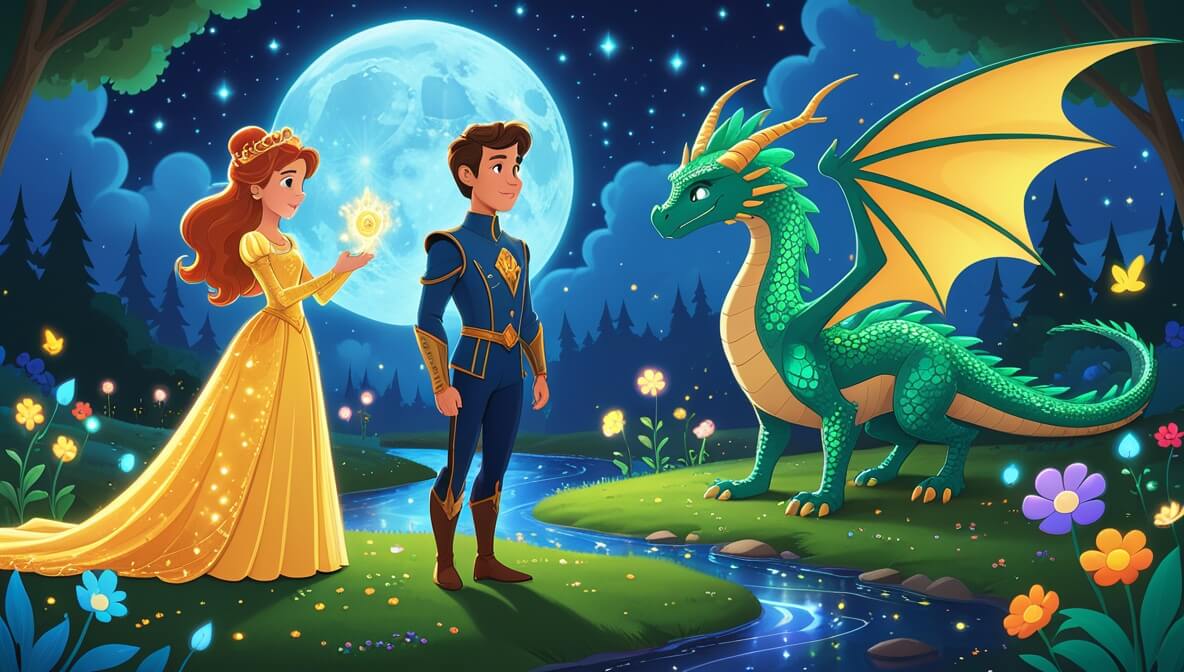In a kingdom where magic blooms like flowers, a brave princess and a kind-hearted knight embark on a magical journey to break a powerful curse that has turned the land into a labyrinth of dreams.
Age Recommendation
3 – 12 years
Characters
Characters:
- Princess Marigold – A courageous young princess with a heart full of dreams.
- Sir Rowan – A noble knight known for his kindness and bravery.
- Wynna the Wise – A fairy godmother with the power of wisdom and light.
- The Shadow Witch – An evil sorceress who casts curses and weaves illusions.
Story
Once upon a time, in the enchanting Kingdom of Luminara, there was a magical garden where dreams came alive under the moonlight. Princess Marigold loved to wander there, dreaming of adventures and wishing for the world to be filled with joy. But one fateful day, the evil Shadow Witch cast a spell, turning the kingdom into a labyrinth where dreams could never escape.
The Garden of Dreams
Princess Marigold, with her golden crown sparkling, decided she must break the curse. She sought help from Sir Rowan, the bravest knight in the kingdom, who always believed in the power of dreams. Together, they ventured into the heart of the magical garden, where Wynna the Wise awaited them.
The Fairy’s Guidance
Wynna, with her shimmering wings, greeted them with a gentle smile. “The power to break the curse lies in the Great Mirror of Truth,” she said. “But beware, the path is full of illusions.” With a wave of her wand, she gifted them a glowing amulet to light their way.
The Labyrinth of Illusions
As they entered the labyrinth, shadows danced around them, whispering doubts and fears. But Marigold and Rowan held the amulet high, its light piercing through the darkness. They encountered many wonders: a field of singing flowers, a river of sparkling stars, and a tree that spoke in riddles.
The Dragon’s First Roar
Deep within the labyrinth, a dragon guarded the path to the mirror. Its roar echoed like thunder, but Marigold, with a voice as gentle as a lullaby, sang a song of peace. The dragon’s eyes softened, revealing its true form—a guardian trapped by the witch’s spell.
A Secret Cave in the Forest
With the dragon’s blessing, they reached a hidden cave where the Great Mirror of Truth lay. Standing before it, Marigold and Rowan saw not only their reflections but the strength of their hearts. Together, they spoke the words of love and courage, shattering the spell.
The Kingdom Reborn
Light burst forth from the mirror, unraveling the labyrinth and freeing the kingdom. The people of Luminara awoke from their dreamless slumber, joy returning to their eyes. The Shadow Witch, defeated by the power of hope, vanished like mist at dawn.
Princess Marigold and Sir Rowan returned to the castle, celebrated by all. They had not only saved the kingdom but also discovered the true power of dreams and friendship.
The end.
Moral of the Story
The story teaches us that even in the darkest times, courage and friendship can light the way. Believing in your dreams and working together can overcome any challenge.
Questions to Think About
- Why is it important to believe in your dreams?
- How did Princess Marigold and Sir Rowan work together to break the curse?
- What role did Wynna the Wise play in their journey?
- How did the dragon change after hearing Marigold’s song?
- What lesson can we learn from the Shadow Witch’s defeat?
Do You Know
- Dragons are often depicted as mythical creatures that can breathe fire and guard treasures in fairy tales.
- Labyrinths are intricate paths or mazes that have been used in stories and myths to symbolize a journey or challenge.
Word Explorer
- Labyrinth: A maze or a complicated network of paths.
- Illusion: Something that looks real but is actually not.
- Amulet: A small object worn for protection or luck.
Emotions in the Story
- Courage: When Marigold decided to break the curse despite the dangers.
- Hope: When the kingdom awoke and joy returned to the people.
- Friendship: When Marigold and Rowan supported each other during the journey.
Color Your Scene
Imagine the moment when Princess Marigold sang to the dragon, turning its roar into a gentle hum. Picture the dragon’s scales shimmering in shades of emerald and gold, with Marigold’s gown flowing like a river of starlight. Draw this scene, filling it with vibrant colors of peace and magic.
Parents’ Corner
This story is a wonderful way to discuss with your child about:
Belief in oneself: Talk about how Marigold’s faith in her dreams guided her through challenges.
Compassion: Discuss how Marigold’s gentle nature helped transform the dragon.
Teamwork: Highlight how Marigold and Rowan’s combined strengths led to their success.
Facing fears: Encourage conversations about confronting and overcoming fears, just like the heroes did with the labyrinth’s illusions.











